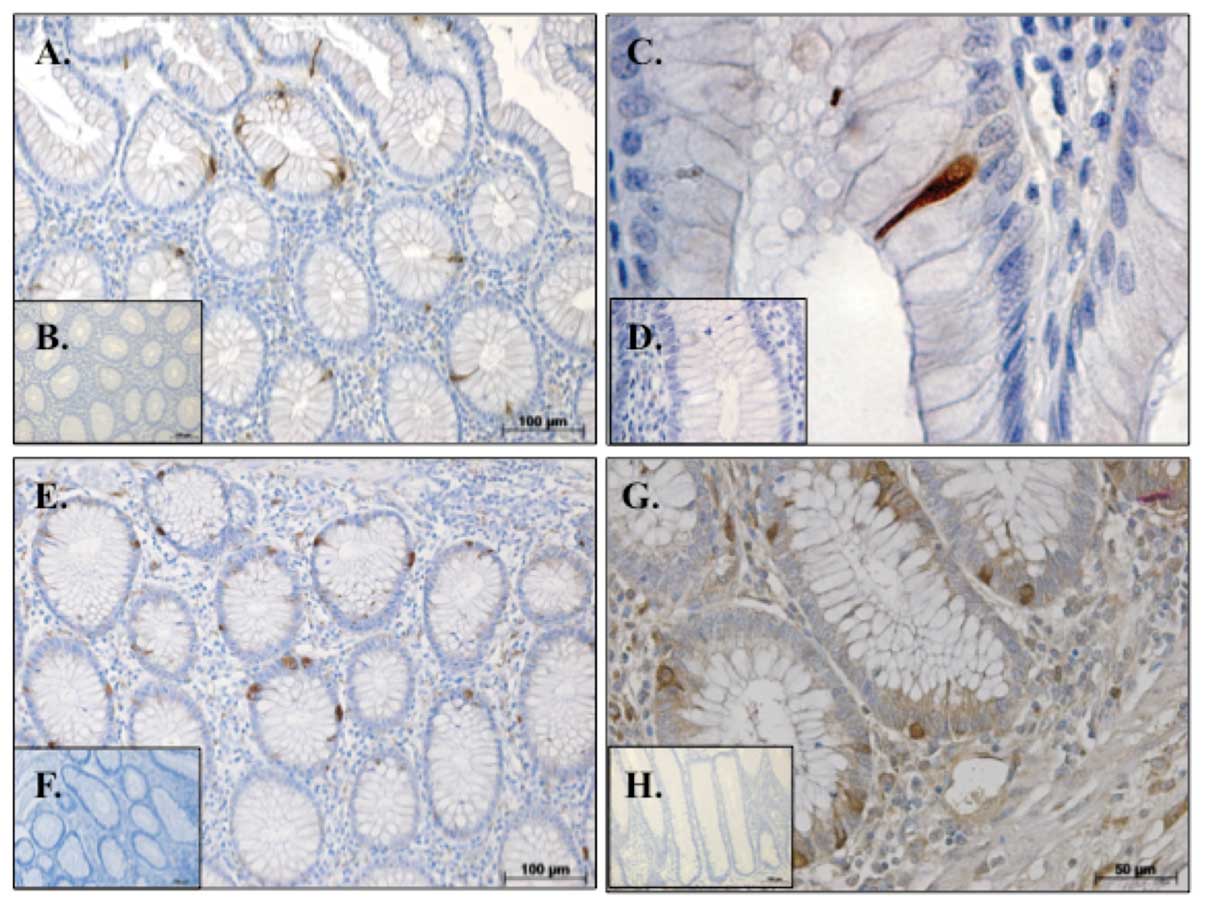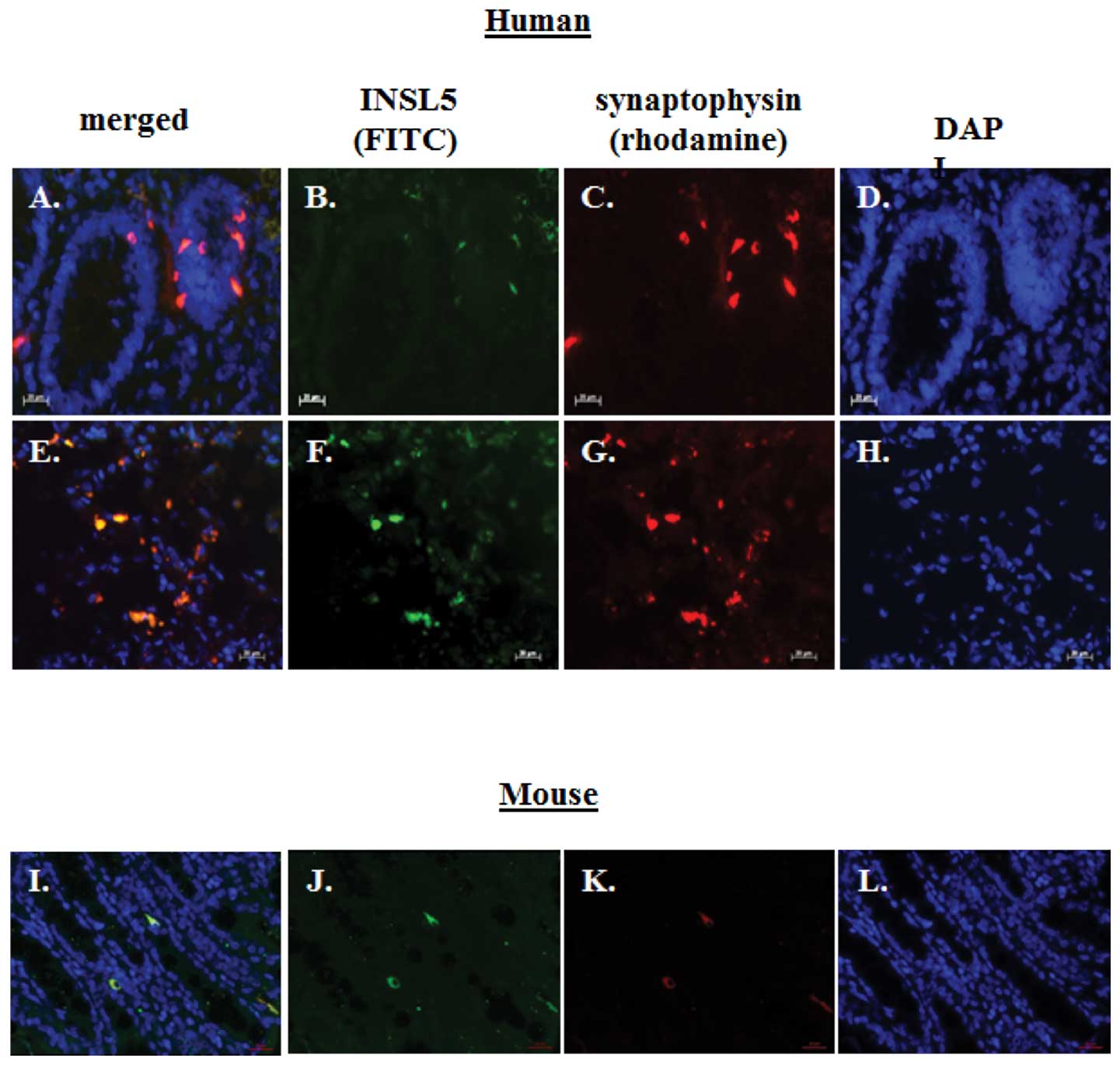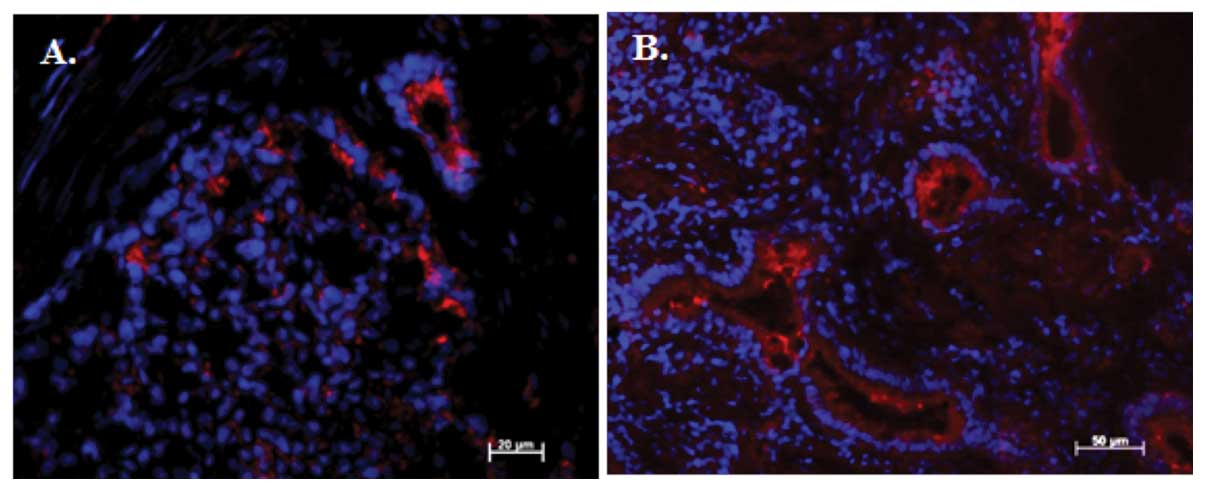|
1
|
Wilkinson TN, Speed TP, Tregear GW and
Bathgate RA: Evolution of the relaxin-like peptide family. BMC Evol
Biol. 5:142005. View Article : Google Scholar : PubMed/NCBI
|
|
2
|
Conklin D, Lofton-Day CE, Haldeman BA, et
al: Identification of INSL5, a new member of the insulin
superfamily. Genomics. 60:50–56. 1999. View Article : Google Scholar : PubMed/NCBI
|
|
3
|
Liu C, Kuei C, Sutton S, et al: INSL5 is a
high affinity specific agonist for GPCR142 (GPR100). J Biol Chem.
280:292–300. 2005. View Article : Google Scholar : PubMed/NCBI
|
|
4
|
Liu C and Lovenberg TW: Relaxin-3, INSL5,
and their receptors. Results Probl Cell Differ. 46:213–237. 2008.
View Article : Google Scholar
|
|
5
|
Liu C, Chen J, Kuei C, et al:
Relaxin-3/insulin-like peptide 5 chimeric peptide, a selective
ligand for G protein-coupled receptor (GPCR)135 and GPCR142 over
leucine-rich repeat-containing G protein-coupled receptor 7. Mol
Pharmacol. 67:231–240. 2005. View Article : Google Scholar : PubMed/NCBI
|
|
6
|
Chen J, Kuei C, Sutton SW, et al:
Pharmacological characterization of relaxin-3/INSL7 receptors
GPCR135 and GPCR142 from different mammalian species. J Pharmacol
Exp Ther. 312:83–95. 2005. View Article : Google Scholar : PubMed/NCBI
|
|
7
|
Liu C, Eriste E, Sutton S, et al:
Identification of relaxin-3/INSL7 as an endogenous ligand for the
orphan G-protein-coupled receptor GPCR135. J Biol Chem.
278:50754–50764. 2003. View Article : Google Scholar
|
|
8
|
Field BC, Chaudhri OB and Bloom SR: Bowels
control brain: gut hormones and obesity. Nat Rev Endocrinol.
6:444–453. 2010. View Article : Google Scholar : PubMed/NCBI
|
|
9
|
Khan WI and Ghia JE: Gut hormones:
emerging role in immune activation and inflammation. Clin Exp
Immunol. 161:19–27. 2010.PubMed/NCBI
|
|
10
|
Moran GW, Leslie FC, Levison SE,
Worthington J and McLaughlin JT: Enteroendocrine cells: neglected
players in gastrointestinal disorders? Therap Adv Gastroenterol.
1:51–60. 2008. View Article : Google Scholar : PubMed/NCBI
|
|
11
|
Rindi G, Leiter AB, Kopin AS, Bordi C and
Solcia E: The ‘normal’ endocrine cell of the gut: changing concepts
and new evidences. Ann NY Acad Sci. 1014:1–12. 2004.
|
|
12
|
Andrew A, Kramer B and Rawdon BB: The
origin of gut and pancreatic neuroendocrine (APUD) cells - the last
word? J Pathol. 186:117–118. 1998. View Article : Google Scholar : PubMed/NCBI
|
|
13
|
Gordon JI: Understanding gastrointestinal
epithelial cell biology: lessons from mice with help from worms and
flies. Gastroenterology. 105:315–324. 1993.PubMed/NCBI
|
|
14
|
Schonhoff SE, Giel-Moloney M and Leiter
AB: Minireview: Development and differentiation of gut endocrine
cells. Endocrinology. 145:2639–2644. 2004. View Article : Google Scholar : PubMed/NCBI
|
|
15
|
May CL and Kaestner KH: Gut endocrine cell
development. Mol Cell Endocrinol. 323:70–75. 2010. View Article : Google Scholar
|
|
16
|
Wiedenmann B, Franke WW, Kuhn C, Moll R
and Gould VE: Synaptophysin: a marker protein for neuroendocrine
cells and neoplasms. Proc Natl Acad Sci USA. 83:3500–3504. 1986.
View Article : Google Scholar : PubMed/NCBI
|
|
17
|
Gunawardene AR, Corfe BM and Staton CA:
Classification and functions of enteroendocrine cells of the lower
gastrointestinal tract. Int J Exp Pathol. 92:219–231. 2011.
View Article : Google Scholar : PubMed/NCBI
|
|
18
|
West NE, Wise PE, Herline AJ, Muldoon RL,
Chopp WV and Schwartz DA: Carcinoid tumors are 15 times more common
in patients with Crohn’s disease. Inflamm Bowel Dis. 13:1129–1134.
2007.PubMed/NCBI
|
|
19
|
Kang H, O’Connell JB, Leonardi MJ, Maggard
MA, McGory ML and Ko CY: Rare tumors of the colon and rectum: a
national review. Int J Colorectal Dis. 22:183–189. 2007. View Article : Google Scholar : PubMed/NCBI
|
|
20
|
Soga J: Carcinoids and their variant
endocrinomas. An analysis of 11842 reported cases. J Exp Clin
Cancer Res. 22:517–530. 2003.PubMed/NCBI
|
|
21
|
Modlin IM and Sandor A: An analysis of
8305 cases of carcinoid tumors. Cancer. 79:813–829. 1997.
View Article : Google Scholar : PubMed/NCBI
|
|
22
|
Modlin IM, Lye KD and Kidd M: A 5-decade
analysis of 13,715 carcinoid tumors. Cancer. 97:934–959. 2003.
View Article : Google Scholar : PubMed/NCBI
|
|
23
|
Soga J: Early-stage carcinoids of the
gastrointestinal tract: an analysis of 1914 reported cases. Cancer.
103:1587–1595. 2005. View Article : Google Scholar : PubMed/NCBI
|
|
24
|
Grabowski P, Schonfelder J, Ahnert-Hilger
G, et al: Heterogeneous expression of neuroendocrine marker
proteins in human undifferentiated carcinoma of the colon and
rectum. Ann NY Acad Sci. 1014:270–274. 2004. View Article : Google Scholar : PubMed/NCBI
|
|
25
|
Okayasu I, Hatakeyama S, Yamada M, Ohkusa
T, Inagaki Y and Nakaya R: A novel method in the induction of
reliable experimental acute and chronic ulcerative colitis in mice.
Gastroenterology. 98:694–702. 1990.PubMed/NCBI
|
|
26
|
Sturiale S, Barbara G, Qiu B, et al:
Neutral endopeptidase (EC 3.4.24.11) terminates colitis by
degrading substance P. Proc Natl Acad Sci USA. 96:11653–11658.
1999. View Article : Google Scholar
|
|
27
|
Ghia JE, Blennerhassett P, Deng Y, Verdu
EF, Khan WI and Collins SM: Reactivation of inflammatory bowel
disease in a mouse model of depression. Gastroenterology.
136:2280–2288. 2009. View Article : Google Scholar : PubMed/NCBI
|
|
28
|
Cooper HS, Murthy SN, Shah RS and
Sedergran DJ: Clinicopathologic study of dextran sulfate sodium
experimental murine colitis. Lab Invest. 69:238–249.
1993.PubMed/NCBI
|
|
29
|
Burnick-Turek O, Mohamed BA, Shirneshan K,
et al: INSL5-deficient mice display an alteration in glucose
homeostasis and impaired fertility. Endocrinology. 153:4655–4665.
2012. View Article : Google Scholar : PubMed/NCBI
|
|
30
|
Bernstein CN, Papineau N, Zajaczkowski J,
Rawsthorne P, Okrusko G and Blanchard JF: Direct hospital costs for
patients with inflammatory bowel disease in a Canadian tertiary
care university hospital. Am J Gastroenterol. 95:677–683. 2000.
View Article : Google Scholar : PubMed/NCBI
|
|
31
|
El-Salhy M, Danielsson A, Stenling R and
Grimelius L: Colonic endocrine cells in inflammatory bowel disease.
J Intern Med. 242:413–419. 1997. View Article : Google Scholar : PubMed/NCBI
|
|
32
|
Wang H, Steeds J, Motomura Y, et al:
CD4+ T cell-mediated immunological control of
enterochromaffin cell hyperplasia and 5-hydroxytryptamine
production in enteric infection. Gut. 56:949–957. 2007.
|
|
33
|
Ahonen A, Kyosola K and Penttila O:
Enterochromaffin cells in macrophages in ulcerative colitis and
irritable colon. Ann Clin Res. 8:1–7. 1976.PubMed/NCBI
|
|
34
|
Klonisch T, Bialek J, Radestock Y,
Hoang-Vu C and Hombach-Klonisch S: Relaxin-like ligand-receptor
systems are autocrine/paracrine effectors in tumor cells and
modulate cancer progression and tissue invasiveness. Adv Exp Med
Biol. 612:104–118. 2007. View Article : Google Scholar
|
|
35
|
Jaspers S, Lok S, Lofton-Day CE, et al:
The Genomics of Insulin 5. Kluwer Academic Publishers; Dordrecht:
2001
|
|
36
|
Jahn R, Schiebler W, Ouimet C and
Greengard P: A 38,000-dalton membrane protein (p38) present in
synaptic vesicles. Proc Natl Acad Sci USA. 82:4137–4141. 1985.
View Article : Google Scholar : PubMed/NCBI
|
|
37
|
Gould VE, Lee I, Wiedenmann B, Moll R,
Chejfec G and Franke WW: Synaptophysin: a novel marker for neurons,
certain neuroendocrine cells, and their neoplasms. Hum Pathol.
17:979–983. 1986. View Article : Google Scholar : PubMed/NCBI
|
|
38
|
Buffa R, Rindi G, Sessa F, et al:
Synaptophysin immunoreactivity and small clear vesicles in
neuroendocrine cells and related tumours. Mol Cell Probes.
1:367–381. 1987. View Article : Google Scholar : PubMed/NCBI
|
|
39
|
Bjerknes M and Cheng H: Neurogenin 3 and
the enteroendocrine cell lineage in the adult mouse small
intestinal epithelium. Dev Biol. 300:722–735. 2006. View Article : Google Scholar : PubMed/NCBI
|
|
40
|
Cortina G, Smart CN, Farmer DG, et al:
Enteroendocrine cell dysgenesis and malabsorption, a
histopathologic and immunohistochemical characterization. Hum
Pathol. 38:570–580. 2007. View Article : Google Scholar : PubMed/NCBI
|
|
41
|
Skipper M and Lewis J: Getting to the guts
of enteroendocrine differentiation. Nat Genet. 24:3–4. 2000.
View Article : Google Scholar : PubMed/NCBI
|
|
42
|
Bishop AE, Pietroletti R, Taat CW,
Brummelkamp WH and Polak JM: Increased populations of endocrine
cells in Crohn’s ileitis. Virchows Arch A Pathol Anat Histopathol.
410:391–396. 1987.PubMed/NCBI
|
|
43
|
Linden DR, Chen JX, Gershon MD, Sharkey KA
and Mawe GM: Serotonin availability is increased in mucosa of
guinea pigs with TNBS-induced colitis. Am J Physiol Gastrointest
Liver Physiol. 285:G207–G216. 2003. View Article : Google Scholar : PubMed/NCBI
|
|
44
|
Oshima S, Fujimura M and Fukimiya M:
Changes in number of serotonin-containing cells and serotonin
levels in the intestinal mucosa of rats with colitis induced by
dextran sodium sulfate. Histochem Cell Biol. 112:257–263. 1999.
View Article : Google Scholar : PubMed/NCBI
|
|
45
|
O’Hara JR, Ho W, Linden DR, Mawe GM and
Sharkey KA: Enteroendocrine cells and 5-HT availability are altered
in mucosa of guinea pigs with TNBS ileitis. Am J Physiol
Gastrointest Liver Physiol. 287:G998–G1007. 2004.PubMed/NCBI
|
|
46
|
Ghia JE, Li N, Wang H, et al: Serotonin
has a key role in pathogenesis of experimental colitis.
Gastroenterology. 137:1649–1660. 2009. View Article : Google Scholar : PubMed/NCBI
|
|
47
|
Feng S, Agoulnik IU, Truong A, et al:
Suppression of relaxin receptor RXFP1 decreases prostate cancer
growth and metastasis. Endocr Relat Cancer. 17:1021–1033. 2010.
View Article : Google Scholar : PubMed/NCBI
|
|
48
|
Vinall RL, Mahaffey CM, Davis RR, et al:
Dual blockade of PKA and NF-κB inhibits H2 relaxin-mediated
castrate-resistant growth of prostate cancer sublines and induces
apoptosis. Horm Cancer. 2:224–238. 2011.
|
|
49
|
Hombach-Klonisch S, Bialek J, Radestock Y,
et al: INSL3 has tumor-promoting activity in thyroid cancer. Int J
Cancer. 127:521–531. 2010. View Article : Google Scholar : PubMed/NCBI
|
|
50
|
Akhter Hossain M, Bathgate RA, Kong CK, et
al: Synthesis, conformation, and activity of human insulin-like
peptide 5 (INSL5). Chembiochem. 9:1816–1822. 2008.PubMed/NCBI
|
|
51
|
Belgi A, Hossain MA, Shabanpoor F, et al:
Structure and function relationship of murine insulin-like peptide
5 (INSL5): free C-terminus is essential for RXFP4 receptor binding
and activation. Biochemistry. 50:8352–8361. 2011. View Article : Google Scholar : PubMed/NCBI
|

















